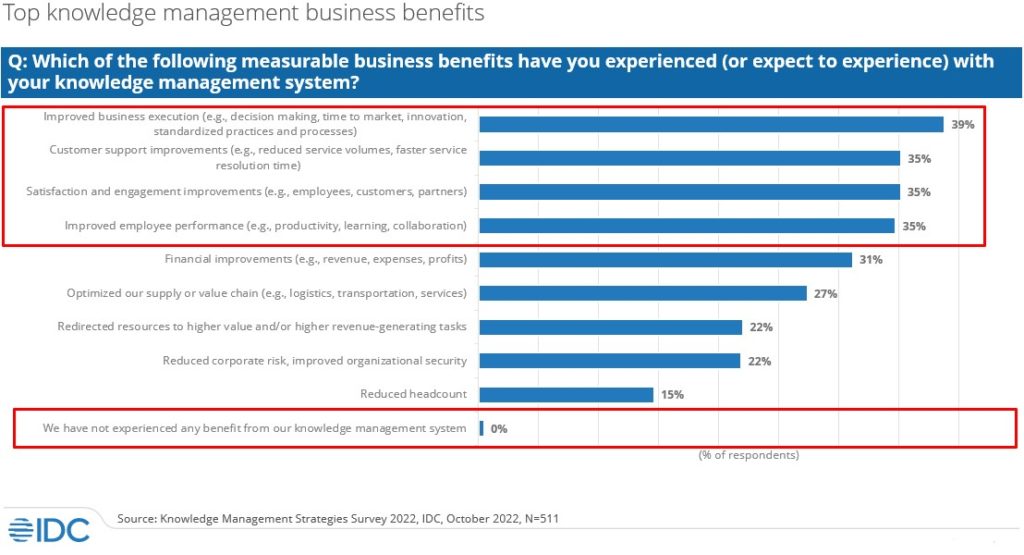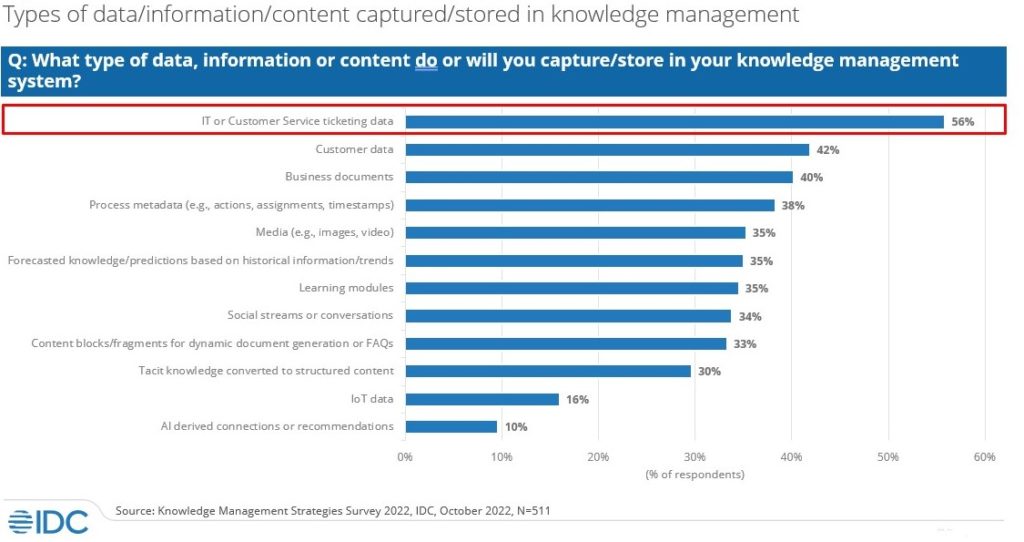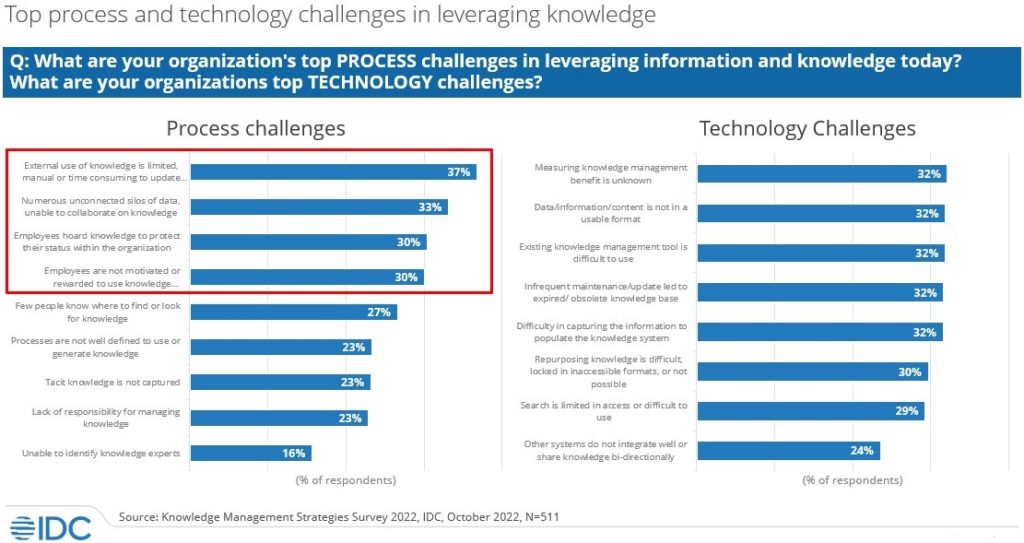A common challenge for many organizations is to accumulate and maintain valuable knowledge gained by employees as a function of their jobs. The problem is that most organizational knowledge is not effectively captured, shared, and utilized. This means you are leaving a valuable resource untapped and, more importantly, don’t have the ability to transform knowledge into insights for better decision-making.
So…a formalized system — to capture, create, share, use, and access knowledge — is important for today’s workplace. The huge volume of knowledge gained by employees should be converted into something usable for the current and future organization and available on-demand for others to leverage. This is where knowledge management technology comes into play.
What is Knowledge Management?
Knowledge management sounds simple enough to have some sense of what it is. IDC formally defines knowledge management as “technologies and processes designed to enable organizational insights and meet business objectives by capturing, creating, sharing, using, and accessing knowledge. Additionally, knowledge can be derived from tacit, structured, unstructured, learned, analyzed, or processed information.”
Knowledge management offers a path for better decision-making, which leads to real, measurable bottom-line benefits like greater efficiency, more innovation, data driven decision-making, and higher customer satisfaction. You can act and react to quickly changing market dynamics by making existing knowledge easy to find and usable in an established data repository.
Why Knowledge Management?
OK…we know what it is – now what? The good news is that IDC research has uncovered several reasons why organizations implement knowledge management system. What’s interesting is that the identified motivators come from many unique perspectives – collaboration, protection, training, etc. – to create different types of positive impact. Most respondents picked between 1-3 key motivators as rationale to deploy or plan to deploy a knowledge management system. The most common responses included:
- Improving the overall collaborative work experience. Knowledge management can drive efficient collaboration by improving the employee/customer/partner experience of sharing knowledge. It also enables more employee self-service processes to quickly find and retrieve knowledge that enhances productivity and helps to reduce support requirements.
- Protecting and maintaining knowledge. A knowledge management system establishes protection and maintenance of legacy knowledge that could be lost due to employee attrition.
- Training/onboarding new employees. A central repository of organizational knowledge allows new team members to quickly come up to speed on company operations and job responsibilities. The time and effort to train and onboard new employees can be vastly improved by making knowledge easily accessible.
Knowledge management isn’t new. It’s been around for several years, so why is now the right time to take a closer look at this technology? Frankly, it’s because the technology infrastructure is better now. The market landscape continues to transition toward a digital-first mentality and knowledge management is part of that evolution. Consider knowledge management as part of your overall IT evolution in how organizations use, access, and manage their business content.
A recent IDC survey shows that the numerous named benefits from knowledge management systems tie in with the previously mentioned motivators (see Figure 1). The top four benefits highlight improvements in business execution, customer support, satisfaction, and employee performance that address operational gains in the business overall. Ultimately, these benefits lead to a positive bottom-line financial impact and plainly make the case for knowledge management as an essential business operations tool.

Perhaps one of the most compelling points identified in the data is that virtually no respondent (<1%) indicated no benefit from implementing knowledge management. These benefits drive an awareness that knowledge management offers a solid return on its investment.
Knowledge Management Use is Expanding, But…
It isn’t fully saturated. IDC research revealed that only 45% of employees of large-sized companies (500+ employees) that have implemented knowledge management in their organizations are, in fact, using it. Obviously, this is less than half of the employee base on average. In two years, this percentage rises to 55%, so the use of knowledge management is expanding at a steady, gradual pace. While the increase is encouraging, it also indicates that there is considerable room in the longer term to increase employee usage to a level that more aligns with what would be common everyday use across most, if not all, employees. We’re not close to that today, but certainly there is potential to move in this direction.
Figure 2 notes that knowledge management systems address a wide range of organizational information. Given that the top use identified in the survey is in the compliance/records management and IT departments, the highest percentage of data stored in knowledge management is IT or customer service ticketing data at 56%. This data type corresponds with the compliance/records management and IT departments where knowledge management usage is highest. However, we also find a large variety of information assets residing in these systems as well, including customer data, business documents, process metadata, rich media, forecasted knowledge, learning modules, social streams/conversations and content blocks/fragments for dynamic document generation and others. It demonstrates knowledge management’s ability to manage all sorts of content and data types.

Some Challenges to Overcome
Of course, knowledge management systems are still evolving and there are considerable process and technology challenges to address (see Figure 3). The IDC survey identified the top process challenge as the “external use of knowledge is limited, manual and/or time consuming to update and maintain”. Other significant process challenges highlight that:
- Numerous unconnected silos of data make collaboration difficult
- Employee behavior such as hoarding knowledge, not being incented to use knowledge management or not knowing where to find/look for knowledge isn’t yet where it needs to be to optimize knowledge management
All these process challenges highlight an inadequate level of organizational commitment to managing knowledge. In such cases, the organization does not take the necessary time and effort to commit to managing knowledge or the organization does not instill an urgency for its employees to use knowledge management.

The range of technology challenges are clustered closely together and speak to considerable usability issues that remain in play and limit adoption. Several organizations also complain of the inability to determine any true benefit from its use, even though almost all organizations using knowledge management indicate beneficial gain.
We anticipate that knowledge management providers will recognize these challenges and work diligently to address them in the near term. This will foster greater adoption of knowledge management systems as a standard requirement in business operations.
Conclusion
Managing organizational knowledge is no longer a nice-to-have benefit. It is a critically important tool for efficiently maintaining organizational information and to remain competitive in a rapidly evolving technology ecosystem. Knowledge management creates a formalized process for the organization to leverage and capitalize on the employee insights gained for current and future use. The array of benefits identified in the IDC survey clearly notes knowledge management’s positive impact on internal employees as well as external constituents that interact with the firm. Challenges do exist, but we believe that many of these identified challenges will be addressed with evolving future generations of knowledge management as its presence becomes standard for the enterprise.
Our advice is to be ahead of the curve. For those who have already adopted the technology, the opportunity is now to increase usage between your employees and with appropriate parties outside of the organization to fully achieve maximum benefit. For those thinking about adding knowledge management as part of the organization’s IT infrastructure, it’s not too late, but the time to act is now. Knowledge management is an avenue to keep pace with the increasingly contested competitive landscape. In the not-too-distant future, we anticipate a notable competitive advantage available to those firms that adopt knowledge management versus those who continue to hold out.




